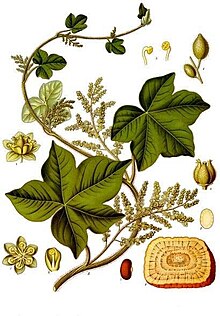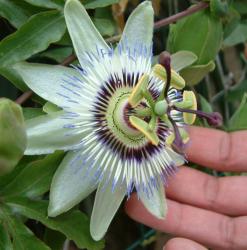
The Passifloraceae are a family of flowering plants, containing about 750 species classified in around 27 genera.

Iochroma is a genus of about 34 species of shrubs and small trees belonging to the nightshade family Solanaceae. Species are native from Mexico to south Brazil. They are found in the forests of Mexico and South America. Their hummingbird-pollinated flowers are tubular or trumpet-shaped, and may be blue, purple, red, yellow, or white, becoming pulpy berries. The cupular (cup-shaped) calyx is inflated in some species. The leaves are alternate, simple, and entire.

Discaria is a genus of 6 species of flowering plants in the family Rhamnaceae, native to temperate regions of the Southern Hemisphere, in Australia, New Zealand and South America.

Menispermaceae is a family of flowering plants. The alkaloid tubocurarine, a neuromuscular blocker and the active ingredient in the 'tube curare' form of the dart poison curare, is derived from the South American liana Chondrodendron tomentosum. Several other South American genera belonging to the family have been used to prepare the 'pot' and 'calabash' forms of curare. The family contains 78 genera with some 440 species, which are distributed throughout low-lying tropical areas with some species present in temperate and arid regions.

Cocculus is a genus of four species of woody vines and shrubs, native to tropical and subtropical regions of Africa and Asia.

Jateorhiza palmata (calumba) is a perennial climbing plant from East Africa. It contains isoquinoline alkaloids and is used mainly as a bitter tonic especially in cases of anorexia nervosa. It contains no tannins, hence it can be safely used in iron preparations for the treatment of anaemia without the fear of precipitation resulted from in vitro interaction.
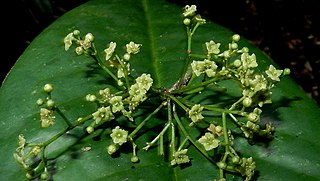
Tontelea is a genus of plants in the family Celastraceae.

John Miers, FRS FLS, knight grand cross of the Order of the Rose, was a British botanist and engineer, best known for his work on the flora of Chile and Argentina.
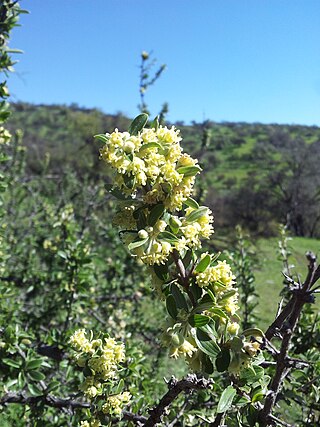
Trevoa is a genus of actinorhizal plants; these dicotyledon flora are trees or small shrubs. The genus was first proposed by Miers in 1825, but was not fully described until 1830 by Sir William Jackson Hooker. Genus members are notable for their ability to fix nitrogen. Species of this genus are generally found in the near coastal forests and arid shrubland of South America. Some species are localized in the mountains of central Chile; for example, the species Trevoa trinervis occurs in the La Campana National Park and other proximate areas of central Chile.
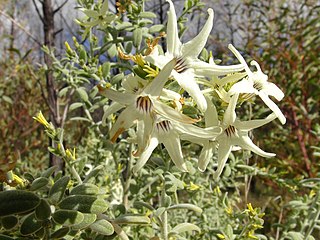
Cyphanthera is a genus of nine species of flowering plants in the family Solanaceae and are endemic to Australia.
Desmostachya is a genus of grass in the family Poaceae. It is native to Africa and Asia.

Miersia is a plant genus in the Amaryllidaceae. The genus has 10 known species, 9 of which are endemic to Chile and one, M. rusbyi, endemic to Bolivia.
Miersiella is a monotypic genus of flowering plants in the Burmanniaceae, first described as a genus in 1903. It contains only one known species, Miersiella umbellataUrb. It is native to South America.
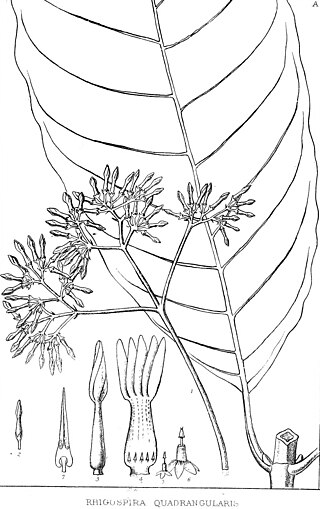
Rhigospira is a genus of flowering plants in the family Apocynaceae, first described as a genus in 1878 by John Miers. The species, Rhigospira quadrangularis was first described as Ambelania quadrangularis by Johannes Müller Argoviensis in 1860 but was transferred to the genus, Rhigospira, in 1878 by John Miers. The genus contains only one known species, Rhigospira quadrangularis, native to northwestern South America.
Aptandra is a genus of flowering plants. In the APG IV system, the genus is placed in the family Olacaceae. Other sources place it in the segregate family Aptandraceae.

Dyssochroma is a genus of flowering plants belonging to the family Solanaceae.
Hylenaea is a genus of flowering plants belonging to the family Celastraceae.
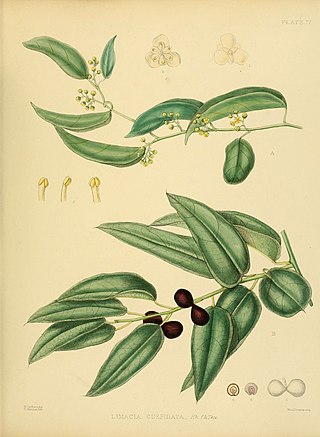
Hypserpa is a genus of flowering plants belonging to the family Menispermaceae.
Saracha is a genus of flowering plants belonging to tribe Physaleae of subfamily Solanoideae of the nightshade family Solanaceae. The genera most closely related to Saracha are Iochroma, Dunalia and Vassobia.

Salpichroa is a genus of flowering plants belonging to the family Solanaceae.
